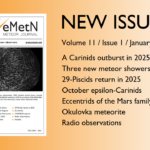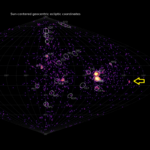Abstract: Worldwide Radio Meteor Observations detected activity of the October Camelopardalids and the October Draconids during the first ten days of October 2020. Their peak times occurred respectively at λʘ = 192.61° with an estimated ZHR of 20 and at λʘ = 194.05° with an estimated ZHR of 25.
1. Introduction
Radio meteor observations in the world covered the meteor shower activity of the October Camelopardalids and the October Draconids 2020. Worldwide radio meteor observation data were provided by the Radio Meteor Observation Bulletin (RMOB)1 (Steyaert, 1993) and by the radio meteor observations network in Japan (Ogawa et al., 2001).
The October Camelopardalids displayed an estimated ZHR of over 40 in 2016. For the 2020 return no dust trail encounters were predicted. For the October Draconids 2020 there were two trail encounters based on calculations by J. Vaubaillon and P. Jenniskens on October 7, at 01h25m UT (the 1704-trail) and at 01h57m UT (1711-trail). (Rendtel, 2019).
2. Method
For analyzing worldwide radio meteor observation data, meteor activities are calculated by the “Activity Level” index (Ogawa et al., 2001). The activity profile was estimated by the Lorentz activity profile (Jenniskens, 2000). Besides of this analysis, also the Zenithal Hourly Rates were estimated (Sugimoto, 2017).
3. Results
3.1. October Camelopardalids (OCT#208)
Figure 1 shows the result for the October Camelopardalids 2020 based on calculations by Hirofumi Sugimoto. The activity showed an estimated maximum ZHR = 20 on October 5 17h UT (λʘ = 192.61°). On the other hand, however, the calculation based on the Activity Level did not detect any unusual activity. Therefore, it is possible that the ZHR was weaker than the estimated value calculated by Hirofumi Sugimoto.

Figure 1 – Estimated ZHR by radio meteor observations (provided by Hirofumi Sugimoto).
3.2. October Draconids (DRA#009)
The unusual activity has been calculated based on 39 observations from 12 countries. Figure 2 shows the result based on the Activity Level index. The peak time was estimated at October 7 3h UT (λʘ = 194.05°). The full width half maximum (FWHM) had –3.0hr / +1.5hr. Although the maximum peak time was earlier than predictions, the ascending branch was longer than the descending branch. Figure 3 shows the activity around the peak time. Besides of the Activity Level index, the estimated ZHR based on calculations by Sugimoto are plotted.

Figure 2 – October Draconids 2020 using Activity Level index by worldwide radio meteor observations.

Figure 3 – Activity profile around the peak with the Activity Level index and the estimated ZHR.
Acknowledgment
The October Camelopardalids and October Draconids data were provided by the following observers:
Chris Steyaert (Belgium), Felix Verbelen (Belgium), Johan Coussens (Belgium), DanielD SAT01_DD (France), Jacques Molne (France), Jean Marie F5CMQ (France), Pierre Micaletti (France), Fred Espey (Germany), WHS Essen (Germany), Per DL0SHF (Germany), Balogh Laszlo (Hungary), AAV Planetario_di_Venezia (Italy), Associazione Pontina di Astronomia _APA_ (Italy), GAML Osservatorio_Astronomico_Gorga(Italy), Mario Bombardini (Italy), Oss_Monte_San_Lorenzo DLF (Italy), Fabio Moschini_IN3GOO (Italy), Hirofumi Sugimoto (Japan), Hironobu Shida (Japan), Hirotaka Otsuka (Japan), Kenji Fujito (Japan), Masaki Kano (Japan), Masaki Tsuboi (Japan), Nobuo Katsura (Japan), Tomohiro Nakamura (Japan), Salvador Aguirre (Mexico), Kees Meteor (Netherlands), RondaRonda (Spain), Jochen Richert (Switzerland), Ian Evans (UK), Philip Norton (UK), Eric Smestad_KC0RDD (USA), Mike Otte (USA), Stan Nelson (USA).
The worldwide data were provided by the Radio Meteor Observation Bulletin (RMOB) (http://www.rmob.org/).
References
Jenniskens P., Crawford C., Butow S. J., Nugent D., Koop M., Holman D., Houston J., Jobse K., Kronk G., and Beatty K. (2000). “Lorentz shaped comet dust trail cross section from new hybrid visual and video meteor counting technique imprications for future Leonid storm encounters”. Earth, Moon and Planets, 82–83, 191–208.
Ogawa H., Toyomasu S., Ohnishi K., and Maegawa K. (2001). “The Global Monitor of Meteor Streams by Radio Meteor Observation all over the world”. In, Warmbein Barbara, editor, Proceeding of the Meteoroids 2001 Conference, 6-10 August 2001, Swedish Institute of Space Physics, Kiruna, Sweden. ESA Publications Division, European Space Agency, Noordwijk, The Netherlands,
pages 189–191.
Rendtel J. (2019). 2020 Meteor Shower Calendar. International Meteor Organization.
Sugimoto H. (2017). “The New Method of Estimating ZHR using Radio Meteor Observations”. eMetN, 2,
109–110.




